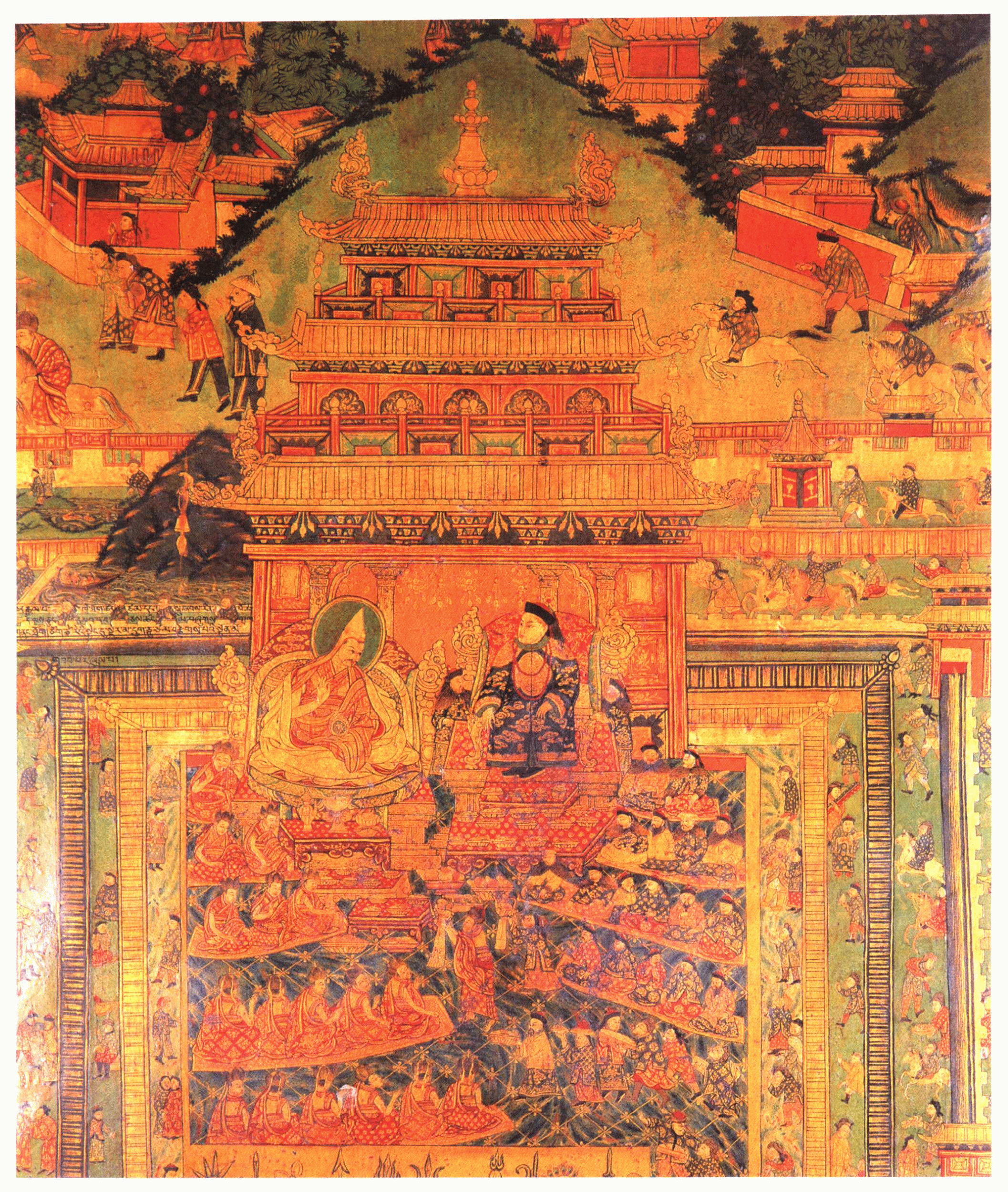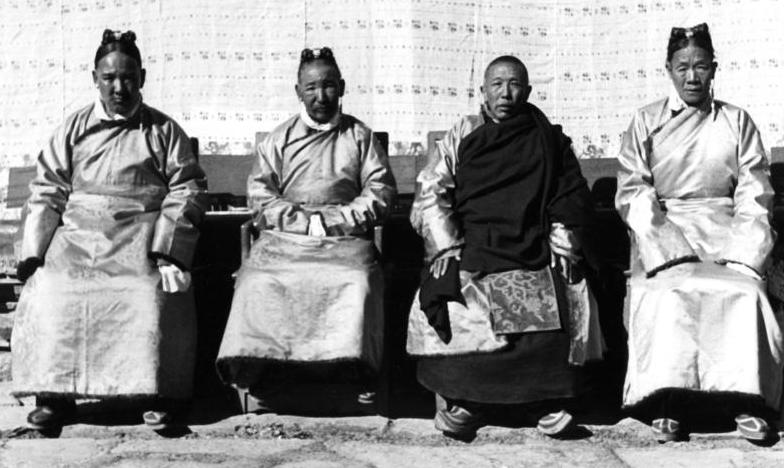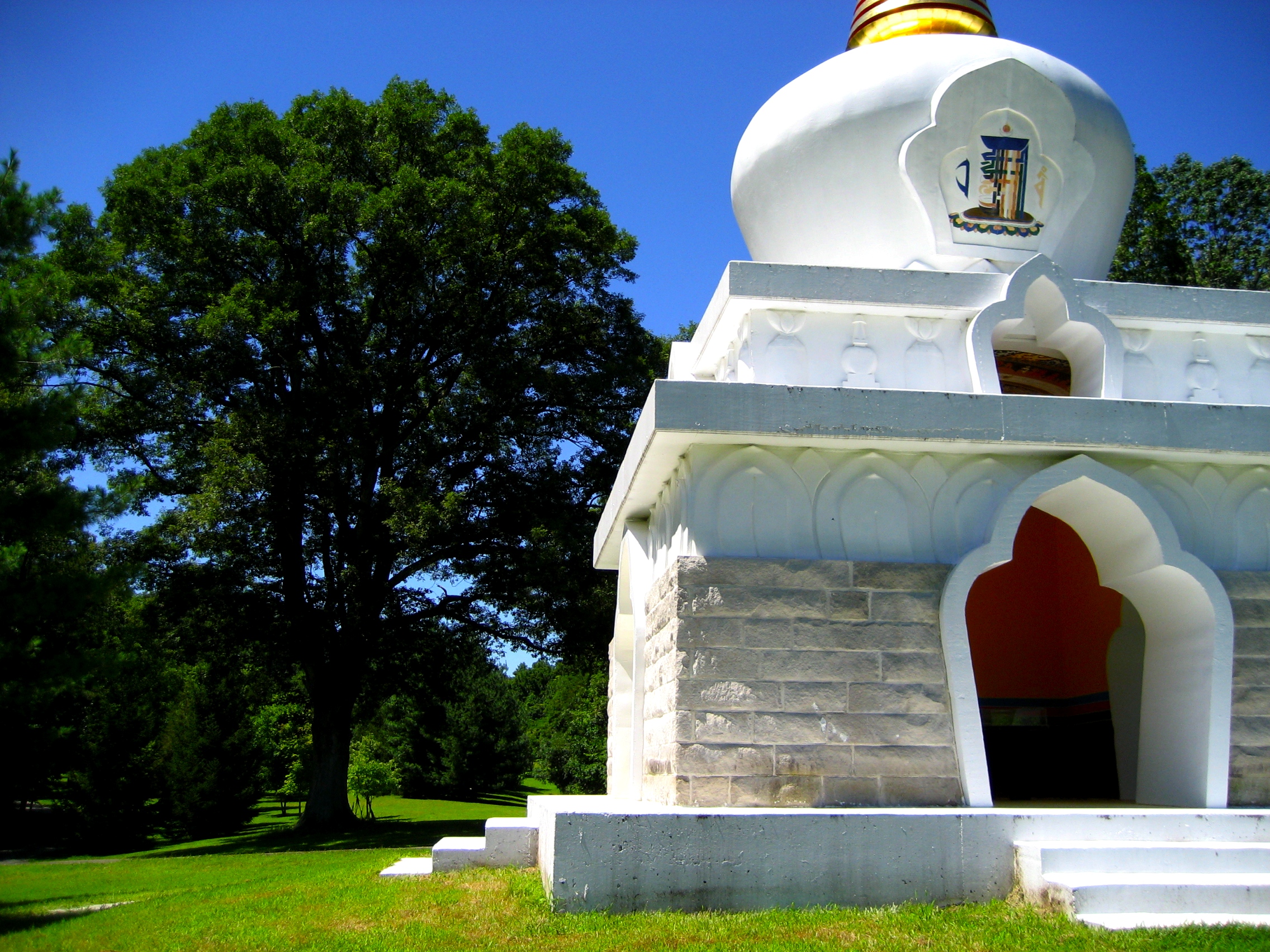|
Shakabpa
Tsepon Wangchuk Deden Shakabpa (, January 11, 1907 – February 23, 1989) was a Tibetan people, Tibetan nobleman, scholar, statesman and former Finance Minister of the government of Tibet (1912–1951), Tibet. Biography Tsepon Shakabpa was born in Lhasa Tibet. His father, Laja Tashi Phuntsok Shakabpa was a senior lay official in charge of the government treasury, and the steward of Lhasa. His father's brother was Trimon Norbu Wangyal, who became the most influential minister in the cabinet of the 13th Dalai Lama. His mother was Samdup Dolma, from the Ngodrupding family. The third Reting Gyalpo Ngawang Yeshe Tsultrim Gyaltsen was born into the Ngodrupding family, and ruled Tibet as Regent from 1845 to 1862. His mother's older brother was Lonchen Changkyim, one of the group of three Prime Ministers during the reign of the 13th Dalai Lama. The younger brother of his mother, was Ngoshi Jampa Thuwang, personal physician of the 13th Dalai Lama. Both his maternal uncles accompanied the ... [...More Info...] [...Related Items...] OR: [Wikipedia] [Google] [Baidu] |
Dalai Lama
Dalai Lama (, ; ) is a title given by the Tibetan people to the foremost spiritual leader of the Gelug or "Yellow Hat" school of Tibetan Buddhism, the newest and most dominant of the four major schools of Tibetan Buddhism. The 14th and current Dalai Lama is Tenzin Gyatso, who lives as a refugee in India. The Dalai Lama is also considered to be the successor in a line of tulkus who are believed to be incarnations of Avalokiteśvara, the Bodhisattva of Compassion. Since the time of the 5th Dalai Lama in the 17th century, his personage has always been a symbol of unification of the state of Tibet, where he has represented Buddhist values and traditions. The Dalai Lama was an important figure of the Geluk tradition, which was politically and numerically dominant in Central Tibet, but his religious authority went beyond sectarian boundaries. While he had no formal or institutional role in any of the religious traditions, which were headed by their own high lamas, he was a unify ... [...More Info...] [...Related Items...] OR: [Wikipedia] [Google] [Baidu] |
Tsoltim Ngima Shakabpa
Tsoltim Ngima Shakabpa (born 7 September 1943 in Lhasa) is a Tibetan banker, activist, writer and poet, one of the first to write in English, composing poems in this language in 1967. Son of the Tibetan Finance Minister Tsepon W. D. Shakabpa, he left Tibet in 1950 to study at the extremely prestigious St. Joseph's School, Darjeeling in India before working for the Tibetan government in exile and settle in the United States and was naturalized American. Biography Tsoltim Ngima Shakabpa is the youngest son of the Minister of Finance of the Tibetan Government in 1939-1950 Tsepon W. D. Shakabpa.''Voice of Tibet - a foreword by Robert Barnett'' , '''', 5 juillet 2 ... [...More Info...] [...Related Items...] OR: [Wikipedia] [Google] [Baidu] |
Tibet (1912–1951)
Tibet was a ''de facto'' independent state between the collapse of the Manchu-led Qing dynasty in 1912 and its annexation by the People's Republic of China in 1951. ; The Tibetan Ganden Phodrang regime was a protectorate of the Qing dynasty until 1912. When the provisional government of the Republic of China was formed, it received an imperial edict giving it control over all the territories of the Qing dynasty. However, it was unable to assert any authority in Tibet. The Dalai Lama declared that Tibet's relationship with China ended with the fall of the Qing dynasty and proclaimed independence. Tibet and Outer Mongolia also signed a treaty proclaiming mutual recognition of their independence from China. With its proclamation of independence and conduct of its own internal and external affairs in this period, Tibet is regarded as a "''de facto'' independent state" as per international law, although its independence was not formally recognized by any foreign power. After the ... [...More Info...] [...Related Items...] OR: [Wikipedia] [Google] [Baidu] |
Lhasa
Lhasa (; Lhasa dialect: ; bo, text=ལྷ་ས, translation=Place of Gods) is the urban center of the prefecture-level Lhasa City and the administrative capital of Tibet Autonomous Region in Southwest China. The inner urban area of Lhasa City is equivalent to the administrative borders of Chengguan District (), which is part of the wider prefectural Lhasa City. Lhasa is the second most populous urban area on the Tibetan Plateau after Xining and, at an altitude of , Lhasa is one of the highest cities in the world. The city has been the religious and administrative capital of Tibet since the mid-17th century. It contains many culturally significant Tibetan Buddhist sites such as the Potala Palace, Jokhang Temple and Norbulingka Palaces. Toponymy Lhasa literally translates to "place of gods" ( , god; , place) in the Tibetan language. Chengguan literally translates to "urban gateway" () in the Chinese language. Ancient Tibetan documents and inscriptions demonstrate th ... [...More Info...] [...Related Items...] OR: [Wikipedia] [Google] [Baidu] |
Tibet Under Qing Rule
Tibet under Qing rule refers to the Qing dynasty's relationship with Tibet from 1720 to 1912. The political status of Tibet during this period has been the subject of political debate. The Qing called Tibet a ''fanbang'' or ''fanshu'', which has usually been translated as "vassal state." Chinese authorities referred to Tibet as a vassal state up until the 1950s and then as an "integral" part of China. The de facto independent Tibetan government (1912–1951) and Tibetan exiles promote the status of independent nation with only a "priest and patron" relationship between the Dalai Lama and the Qing emperor. Western historians such as Melvyn Goldstein, Elliot Sperling, and Jaques Gernet have described Tibet during the Qing period as a protectorate, vassal state, tributary, or something similar. By 1642, Güshi Khan of Khoshut Khanate had reunified Tibet under the spiritual and temporal authority of the 5th Dalai Lama of the Gelug school. In 1653, the Dalai Lama travelled on a s ... [...More Info...] [...Related Items...] OR: [Wikipedia] [Google] [Baidu] |
Kashag
The Kashag (; ), was the governing council of Tibet during the rule of the Qing dynasty and post-Qing period until the 1950s. It was created in 1721, and set by Qianlong Emperor in 1751 for the Ganden Phodrang in the 13-Article Ordinance for the More Effective Governing of Tibet. In that year the Tibetan government was reorganized after the riots in Lhasa of the previous year. The civil administration was represented by Council (Kashag) after the post of Desi (or Regent; ''see: dual system of government'') was abolished by the Qing imperial court. The Qing imperial court wanted the 7th Dalai Lama to hold both religious and administrative rule, while strengthening the position of the High Commissioners.Seventh Dalai Lama Kelsang Gyatso ''The Dalai Lamas of Tibet'', p. 101. Thubten Samphel and T ... [...More Info...] [...Related Items...] OR: [Wikipedia] [Google] [Baidu] |
Kham
Kham (; ) is one of the three traditional Tibetan regions, the others being Amdo in the northeast, and Ü-Tsang in central Tibet. The original residents of Kham are called Khampas (), and were governed locally by chieftains and monasteries. Kham presently covers a land area distributed between five regions in China, most of it in Tibet Autonomous Region and Sichuan, with smaller portions located within Qinghai, Gansu and Yunnan provinces. Densely forested with grass plains, its convergence of six valleys and four rivers supported independent Kham polities of Tibetan warrior kingdoms together with Tibetan Buddhist monastic centers.Jann Ronis"An Overview of Kham (Eastern Tibet) Historical Polities" The University of Virginia The early trading route between Central Tibet and China traveled through Kham, and Kham is said to be the inspiration for Shangri-La in James Hilton's novel. Settled as Tibet's eastern frontier in the 7th century, King Songtsen Gampo built temples along its e ... [...More Info...] [...Related Items...] OR: [Wikipedia] [Google] [Baidu] |
Genghis Khan
Genghis Khan (born Temüjin; ; xng, Temüjin, script=Latn; ., name=Temujin – August 25, 1227) was the founder and first Great Khan (Emperor) of the Mongol Empire, which became the List of largest empires, largest contiguous empire in history after his death. He came to power by uniting many of the nomadic tribes of the Mongol steppe and being proclaimed the universal List of Mongol rulers, ruler of the Mongols, or ''Genghis Khan''. With the tribes of Northeast Asia largely under his control, he set in motion the Mongol invasions and conquests, Mongol invasions, which ultimately witnessed the conquest of much of Eurasia, and incursions by Mongol raiding parties as far west as Legnica in Mongol Empire#Push into central Europe, western Poland and as far south as Gaza City, Gaza. He launched campaigns against the Mongol conquest of the Qara Khitai, Qara Khitai, Mongol conquest of the Khwarazmian Empire, Khwarezmia, the Mongol conquest of Western Xia, Western Xia and Mongol conquest ... [...More Info...] [...Related Items...] OR: [Wikipedia] [Google] [Baidu] |
Tibet During The Ming Dynasty
Tibet (; ''Böd''; ) is a region in East Asia, covering much of the Tibetan Plateau and spanning about . It is the traditional homeland of the Tibetan people. Also resident on the plateau are some other ethnic groups such as Monpa, Tamang, Qiang, Sherpa and Lhoba peoples and now also considerable numbers of Han Chinese and Hui settlers. Since 1951, the entire plateau has been under the administration of the People's Republic of China, a major portion in the Tibet Autonomous Region, and other portions in the Qinghai and Sichuan provinces. Tibet is the highest region on Earth, with an average elevation of . Located in the Himalayas, the highest elevation in Tibet is Mount Everest, Earth's highest mountain, rising 8,848.86 m (29,032 ft) above sea level. The Tibetan Empire emerged in the 7th century. At its height in the 9th century, the Tibetan Empire extended far beyond the Tibetan Plateau, from Central Asian's Tarim Basin and the Pamirs in the west to Yunnan an ... [...More Info...] [...Related Items...] OR: [Wikipedia] [Google] [Baidu] |
People's Republic Of China
China, officially the People's Republic of China (PRC), is a country in East Asia. It is the world's most populous country, with a population exceeding 1.4 billion, slightly ahead of India. China spans the equivalent of five time zones and borders fourteen countries by land, the most of any country in the world, tied with Russia. Covering an area of approximately , it is the world's third largest country by total land area. The country consists of 22 provinces, five autonomous regions, four municipalities, and two Special Administrative Regions (Hong Kong and Macau). The national capital is Beijing, and the most populous city and financial center is Shanghai. Modern Chinese trace their origins to a cradle of civilization in the fertile basin of the Yellow River in the North China Plain. The semi-legendary Xia dynasty in the 21st century BCE and the well-attested Shang and Zhou dynasties developed a bureaucratic political system to serve hereditary monarchies, o ... [...More Info...] [...Related Items...] OR: [Wikipedia] [Google] [Baidu] |
Thubten Jigme Norbu
Thubten Jigme Norbu () (August 16, 1922 – September 5, 2008), recognised as the Taktser Rinpoche, was a Tibetan lama, writer, civil rights activist and professor of Tibetan studies and was the eldest brother of the 14th Dalai Lama, Tenzin Gyatso. He was one of the first high-profile Tibetans to go into exile and was the first to settle in the United States. Early life Thubten Jigme Norbu was born in 1922 in the small, mountain village of Taktser in the Amdo County of Eastern Tibet. Independence walks In 1995, Norbu cofounded the International Tibet Independence Movement (ITIM). He led three walks for Tibet's independence, starting in 1995 with a week-long walk 80 miles from Bloomington, Indiana to Indianapolis, Indiana. In 1996 he led a 300-mile, 45-day walk from the PRC embassy in Washington, DC to the Headquarters of the United Nations, surrounded by New York City. The following year, joined by Dadon with her 3-year-old son, he led a 600-mile walk from Toronto to ... [...More Info...] [...Related Items...] OR: [Wikipedia] [Google] [Baidu] |
Taktser Rinpoche
Taktser Rinpoche (; ) was born in 1922 in "the small village of Taktser, meaning 'roaring tiger,' located in the Amdo region of eastern Tibet." He became a lama of the Gelugpa school of Tibetan Buddhism and was named Thubten Jigme Norbu, the oldest brother of Tenzin Gyatso—the 14th Dalai Lama of Tibet. Soon after birth, he was recognized by the 13th Dalai Lama as the reincarnation of the previous Taktser Rinpoche, who was "one of the thirty or so reincarnated lamas who were a part of Kumbum's tradition." On September 5, 2008, Norbu, 86, died at his Indiana, US, home after illness for many years. He was survived by his wife Kunyang Norbu, and 3 sons. Taktser Lama Thubten Jigme Norbu's predecessor as the Taktser Rinpoche, known as Taktser Lama, was Norbu's and his brother the 14th Dalai Lama's paternal grandmother's elder brother, in other words their great uncle. One of the 30 or so reincarnated lamas who were part of Kumbum Monastery's tradition, he had been recognised as the Ta ... [...More Info...] [...Related Items...] OR: [Wikipedia] [Google] [Baidu] |









